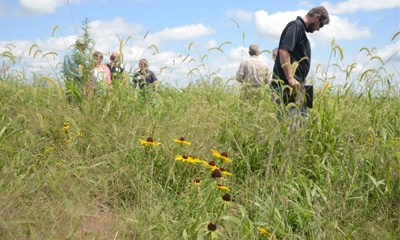December 5, 2019

USDA is opening signup for the Conservation Reserve Program on Dec. 9, 2019. The deadline for agricultural producers to sign up for general CRP is Feb. 28, 2020, while signup for continuous CRP is ongoing.
Farmers and ranchers who enroll in CRP receive a yearly rental payment for voluntarily establishing long-term, resource-conserving plant species, such as approved grasses or trees to control soil erosion, improve water quality and develop wildlife habitat on agricultural lands.
“The Conservation Reserve Program is one of our nation’s largest conservation endeavors and a critical tool to help producers better manage their operations while conserving natural resources,” Agriculture Secretary Sonny Perdue said. “The program marks its 35-year anniversary in 2020, and we’re hoping to see one of our largest signups in many years.”
CRP has 22 million acres enrolled, but the 2018 Farm Bill increased the cap 5 million acres to 27 million acres. This means farmers and ranchers have a chance to enroll in CRP for the first time or continue their participation for another term.
Signed into law in 1985, CRP is one of the largest private-lands conservation programs in the U.S. The program was originally primarily intended to control soil erosion and potentially stabilize commodity prices by taking marginal lands out of production. This Farm Bill program has evolved over the years, providing a variety of conservation and economic benefits from coast to coast. CRP has:
Prevented more than 9 billion tons of soil from eroding, enough soil to fill 600 million dump trucks;
Reduced nitrogen and phosphorous runoff relative to annually tilled cropland by 95% and 85% respectively;
Sequestered an annual average of 49 million tons of greenhouse gases, equal to taking 9 million cars off the road;
Created more than 3 million acres of restored wetlands while protecting more than 175,000 stream miles with riparian forest and grass buffers, enough to go around the world 7 times; and
Benefited bees and other pollinators and increased populations of ducks, pheasants, turkey, bobwhite quail, prairie chickens, grasshopper sparrows and many other birds
CRP Enrollment Options
General Signup - CRP general signup will be held annually. The competitive general signup will now include increased opportunities for enrollment of wildlife habitat through the State Acres For Wildlife Enhancement (SAFE) initiative.
Continuous Signup - While some practices under SAFE will remain available through continuous signup, CRP continuous signup will focus primarily on water quality within the Clean Lakes, Estuaries, and Rivers (CLEAR) Initiative. The 2018 Farm Bill prioritizes water quality practices such as contour grass strips, filter strips, riparian buffers, wetlands and a new prairie strip. USDA will also be working with Conservation Reserve Enhancement Program (CREP) partners to relaunch CREP continuous options in each state under new statutory provisions. CREP will continue to target high-priority local, state or regional conservation concerns.
Grasslands Signups - CRP Grasslands signup helps landowners and operators protect grassland, including rangeland, and pastureland and certain other lands while maintaining the areas as grazing lands. A separate CRP Grasslands signup will be offered each year following general signup. The sign-up period for CRP Grasslands in 2020 runs from March 16, 2020 to May 15, 2020.
Pilot Programs - Later in 2020, USDA’s Farm Service Agency will roll out pilot programs within CRP: CLEAR 30, which allows contracts expiring with CLEAR practices to be reenrolled in 30-year contracts and in the Soil Health and Income Protection Program (SHIPP) in the prairie pothole region. More information on these programs will be announced in the new year.
Land Transition - The CRP Transition Incentives Program (TIP) is an option for producers interested in transitioning land to a beginning farmer or rancher or a member of a socially disadvantaged group to return land to production for sustainable grazing or crop production. CRP contract holders no longer need to be a retired or retiring owner or operator to transition their land. TIP participants may have a lease less than five years with an option to purchase, and they have two years before the end of the CRP contract to make conservation and land improvements.
Previously Expired Land - Land enrolled in CRP under a 15-year contract that expired in September 2017, 2018 or 2019, may be eligible for enrollment if there was no opportunity for re-enrollment and the practice under the expired contract has been maintained.
CRP Rates and Payments - FSA recently posted updated soil rental rates for CRP. County average rates are posted on the CRP Statistics webpage. Soil rental rates are statutorily prorated at 90% for continuous signup and 85% for general signup. The rental rates will be reviewed annually. Under continuous signup, producers also receive incentives, including a signup incentive payment and a practice incentive payment.
Source: USDA, which is solely responsible for the information provided and is wholly owned by the source. Informa Business Media and all its subsidiaries are not responsible for any of the content contained in this information asset.
You May Also Like




